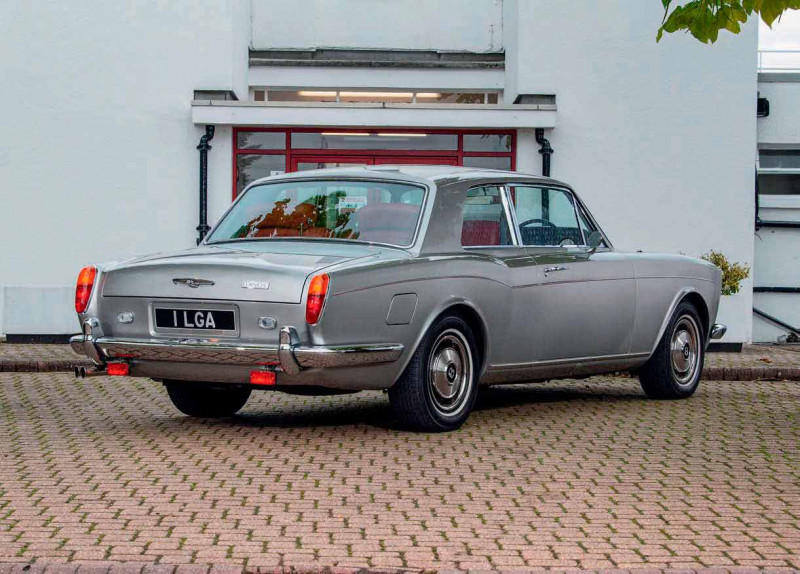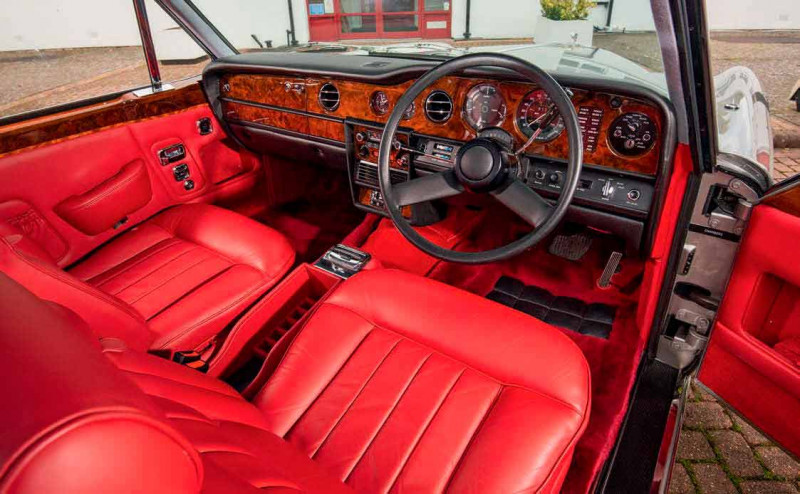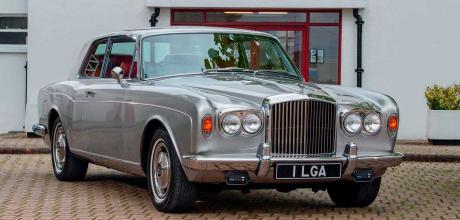1976 Bentley Corniche Series IA Brooklands FHC
We take a trip to Brooklands to meet the man whose rare Bentley Corniche is almost certainly the finest survivor of its kind – a machine restored to an exemplary standard but still used for long-distance adventures. Words: Richard Gunn. Photography: Matt Richardson.
Richard Gunn meets the owner of a superb FHC
CORNICHE CREATION RESTORATION STORY OF ONE OF THE RAREST BENTLEYS OF ITS TIME
“It’s not precious… I drive the Corniche there, going over 12,000-feet mountain passes, and it performs absolutely impeccably”

Bentleys and Brooklands… the two just seem to go together so well. The 1907 home of British motorsport (and aviation) will forever be associated with the marque, as well as the ‘Bentley Boys’ who raced their magnificent machines at the banked Surrey track. So when Rolls-Royce & Bentley Driver got together with Chris Chambers to sample his absolutely sensational 1976 Bentley Corniche Series IA, Brooklands just seemed the natural choice for our photo shoot. Yes, that’s the old aerodrome control tower you can see in the background of some of our shots. London-based companies director Chris has become a bit of a ‘Bentley Boy’ himself since acquiring his Corniche in 2012; purchasing, driving and rebuilding it ultimately inspired him to buy three other classic examples, which he’s now in the process of having restored to the same high standard. And if they turn out even half as good this particular car, they’ll be very special indeed. The Bentley Corniche IA probably needs some explanation, since it’s a far from common model. When the Rolls-Royce Silver Shadow and its Bentley T-series sister were launched in 1965, they were soon joined by two-door saloons from Mulliner Park Ward (Rolls-Royce’s in-house coachbuilder) and James Young, with a convertible variant of the former coming along a year later. James Young exited the scene in 1967, leaving the MPW machines – with their distinctive and very fashionable ‘Coke bottle’ rear wing styling – to dominate the market. In 1971, to further distinguish the two-door cars from the standard saloons, the name Corniche was bestowed on them. This was a revival of a pre-war Bentley title, but despite the moniker being more Winged-B than Spirit of Ecstasy, Bentley versions of the post-war Corniche were very few and far between. With Rolls-Royce being the dominant partner in the marriage of the marques during the 1960s and ’70s, just 53 fixed-head coupé and 45 convertible Bentley Corniche Series Is were built between 1971 and ’77.
The Corniche’s interior is impeccably presented and beautifully detailed

By contrast, there were a somewhat more substantial 780 saloons and 1233 convertibles under the Rolls-Royce banner. Bentley’s revival wouldn’t get under way until the following decade. Company policy at the time was to fit any new upgrades and enhancements to Corniches first, before filtering them down to the standard saloons, which is how Chris’ Series IA variant came to be. Registered in July 1976, just before the switch to the Series II Corniche, it was a transitional machine incorporating many of the modifications of the second-generation cars – such as the split-level air-conditioning, later dashboard and instrumentation, and rack-and-pinion steering, but without the chunky safety-conscious Series II alloy and rubber bumpers which, at least aesthetically, few regarded as an improvement. Think of it as the best of both worlds: “It has all the facets of the later model, with the traditional old chrome,” says Chris. “I think they only made about three Bentleys in this form, so it’s quite a rare car.” He has since found out that it (or at least its chassis number) was featured in several Rolls-Royce manuals because, as a IA, it was the first of its kind to feature the alterations that would become stock on the Series IIs.
“In 1971, to further distinguish the two-door cars from the standard saloons, the name Corniche was bestowed on them”
FINDING THE CAR
It was nine years ago that Chris acquired his Corniche. Although he had a small collection of other prestige cars, none of them were Bentleys, but that was about to change. “It was this car that got me into Bentleys; it’s almost become a bit uncontrolled since then,” he jokes. What was the attraction? Well, he remembers some of his father’s friends owning them when he was growing up and thinking they were fantastic at the time. But there was more to it than that: “I wanted to pick a classic that was not yet so well-appreciated that it had become a big collectors’ piece. The Shadow’s reputation was still quite poor in 2012, but I took the view that this had to change.” It was specifically a Series IA Corniche that Chris wanted, because of its cocktail of older appearance and more advanced running gear and interior appointments, and he eventually found this example at Surrey-based Royce Service & Engineering. “I went with my daughter to see it, took one look and thought ‘It’s a great car, I’ll have it’. I bought it on the spot”. The Bentley was in very good condition, but after 102,000 miles and 36 years, there were inevitably some blemishes and issues that could be improved. So, after a few years of using it regularly and enjoying it, Chris decided it was time to create the perfect Corniche that he really craved: “I took the view that, even though there was nothing massively wrong with it, in order for it to survive the next fifty or sixty years and be an exceptional car, it deserved to have a full engine-out, subframe-out, body-off rebuild.” The company Chris chose in 2018 for the painstaking job was Rolls-Royce and Bentley specialist Hillier Hill, based in the Buckinghamshire town of Olney.
“Ray Hillier and I went through a long list of things that might possibly want to be looked at and decided that a full, no-holds-barred restoration was the way forward.” This encompassed taking the body back to bare metal and attending to all the mechanical aspects of the car, including overhauling the running gear and rebuilding the engine and gearbox. Inside, the vibrant red leather (one of the more distinctive and eye-catching features of this Corniche) and the wood were taken off and refurbished to exacting standards.
Where possible, effort was taken to have original parts restored rather than replaced: “Where we did replace bits, we were often lucky enough to get the last items from Crewe,” recalls Chris. For example, there was the heated rear screen, which had started to de-laminate and go milky. “We located probably the last Pilkington original Corniche heated rear window going. There was no limit to things. We had the build sheets for the car from 1976, so we knew exactly what had gone into it; the leather, the wood, and so on. All the chrome was sent away and redone by Derby Plating Services, so the brightwork is now exceptional.” Chris and Hillier Hill’s attention to originality even included keeping the Blaupunkt radio and Pioneer cassette player. Was there any temptation to go for a more modern sound set-up at all? “No, not even for a nanosecond,” laughs Chris. “They were in the build-spec of the car, so I wanted to keep them. And I’ve still got the Rolls-Royce cassette that teaches you how to use the system.” However, there were a couple of choice improvements made, including the paint shade: “The car was initially Bentley Shell Grey, but I had it finished in Ferrari Grigio Notte. It’s an incredibly subtle change, and you’d have to be a real aficionado to spot it. The problem with the Bentley Shell Grey is that on a dull day the colour just sinks, while the Ferrari shade doesn’t. It just raises the car, makes it better to look at, and interacts with the chrome a bit more. I thought that if I’m going to have this car for the rest of my life, then I’d like it in my own colour. So, it’s the only Bentley Corniche in Ferrari Grigio Notte.”
Upgraded Lobro driveshafts, as found on post-1983 Silver Spirits, were also fitted to overcome the tendency of the original Silver Shadow components to wear out, resulting in vibration and noise most unbecoming of such a prestigious vehicle. The entire restoration took two years, resulting in what Chris – and pretty much everybody else who sees the Corniche – regards as “an exceptional, really beautiful car. I have to take my hat off to Hillier Hill; they did an absolutely outstanding job. The attention to detail was spectacular. Even after the restoration, we then spent six to eight months where they painstakingly went through every single piece that needed slight adjustment, to get it all completely spot-on.” He cites the way the doors close as an aspect he’s particularly pleased with: “These are heavy panels, and the hinges often wear; they’re difficult get right. But now, to close a door, it’s just one gentle push and clunk. It just glides and closes.”
CLOSE TO CONCOURS
In Chris’ opinion, this rare two-door Bentley is now about as close to a 100-point concours d’elegance car as you’re likely to see. However, concours events were never part of his thinking: “I’m not into showing cars, I’m into using them, but I like to know myself that all my cars are as good as they can possibly be.” To that end, even given the Corniche’s exemplary order, Chris isn’t afraid to make full use of it. He’s half-Swiss, half-English, and so has another house away from London, in Switzerland. “It’s not precious. I drive the Corniche there, going over 12,000-feet mountain passes, and it performs absolutely impeccably. As great as it is to look at, it’s the most wonderful machine to drive. For a car that’s the best part of fifty years old, it’s incredibly comfortable; the fable that the only thing you hear inside a Rolls-Royce is the clock is totally true. It’s silent and just drifts and wafts along. It’s a very usable car. I think one of the mistakes that people make with classics is to cocoon them away, because they’re too precious. And it’s no good for the car. A good friend of mine, a specialist, once told me that the best service you can give your car is to drive it regularly. They need to be used.” In fact, so enamoured is Chris with his Corniche that he much prefers it to some of his 21st century vehicles. “It’s a joy – it turns a mundane journey into something special. When I go to Switzerland, it takes about twelve hours in a new Range Rover. It probably takes an hour or two longer in the Bentley, but it’s much, much more enjoyable. It also gets a lot of looks when you stop for petrol in France or Switzerland, or when you’re going down the motorway; people wind their windows down and start taking photographs, which always feels a bit odd.”
He also used the car for his daughter’s wedding, a lovely circle-closing touch given that she was with him at Royce Service & Engineering when he decided to buy it. “That was a big, emotional event anyway, taking my daughter to the church in the Bentley. It was a great day,” muses Chris. While his attention has now moved to bringing his subsequently-acquired Bentleys up to the same standard – Chris also has a 1972 Corniche convertible, a 1958 S1 Continental Fastback and a Continental T – his first Corniche is definitely a keeper. He plans to never get rid of it.
“The long and short of it was that I bought a car that was worth buying. I realised the potential of the car was way in excess of the value of what they could be bought and sold for, if you did it right. So, I took a decision to fast-forward. At some point, these cars are going to be recognised for their styling; I think the lines of the Corniche are exceptional. It will eventually be acknowledged just how rare and spectacular these cars were in their day. I took the view that it deserved to have everything thrown at it, to give it the chance of probably being best in breed for decades to come. It’s now fit for the next fifty or sixty years and, even when I’m no longer around, it will still be a really lovely example.”
“Chris also used the Corniche for his daughter’s wedding, a lovely circle-closing touch given that she was with him when he decided to buy it”
The engine bay is as painstakingly detailed as the rest of this fully-restored Bentley. The car may be a concours contender but Chris is more interested in driving it. Chris Chambers, now a Bentley convert
“The problem with the Bentley Shell Grey is that on a dull day the colour just sinks, while the Ferrari shade doesn’t”



The real weight of this car 6,800 lbs? Jesus, this thing weighs more than our Expedition